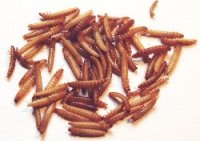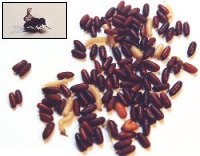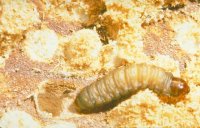|
| Buffalo worms |
| Alphitobius diaperinus |
 |
The adult beetles are shiny black or dark brown, about 5-6 mm long. Its thorax is finely punctured and its wing covers are longitudinally striated or grooved. They are specially active in the dark (nocturnal) and like warmth. The beetle prefers to lay her eggs (200-400) on rotting plant material such as litter and spilled feed. A yellowish-brown smooth larva hatches from the egg in about 4 days under favourable conditions (16 – 27 °C).
This wormlike larva is 7 mm long and lives in litter. They may grow to 15 mm in length. While feeding and growing, the larva will cast its skin from 7 to 11 times in the 47 days it takes to become a pupa. The pupal stage will take an average of 7 days. The newly emerged female beetle will start laying eggs in about 11 days. The complete life cycle, egg to egg, under favourable temperatures and diets is about 71 days.
|
   |
| Cricket |
| Acheta domestica |
 |
Crickets are about 3/4 to 7/8 inch long, and have a yellowish-brown color. They have long, slender antennae which are much longer than the body. The cricket's wings lay flat on its back but are bent down on the sides. The females have a long, tube-like structure coming from their abdomen for the purpose of laying eggs. Like other insects they have 6 legs. Their body is divided into three basic sections the head, thorax, and abdomen. The head includes a brain, mouth antennae, and eyes. The thorax includes the legs and wings. The abdomen is involved in the “living” part: food digesting, breathing, and mating.
Crickets get their name from the high pitched chirp they make. This chirp is produced only by males. The sound is produced by the front wings being rubbed together. They make this chirping sound by rubbing the sharp edge, called the scraper, at the base of one front wing along a file like ridge on the bottom side of the other front wing. The number of chirps can vary it usually dependents on the temperature. The higher the temperature the more or faster the chirps are. The number can vary from 4 to 5 to more than 200 per second. These chirps are amplified by the wing surface. Each species of crickets have their own chirp. The males use this call to attract a mate or to identify the cricket’s territory. There are special songs for courtship, fighting, and for sounding an alarm.
|
   |
| Flies (not flying) |
| Musca Domestica |
 |
Adults usually live 15 to 25 days. The housefly has a complete metamorphosis with distinct egg, larva or maggot, pupal and adult stages. The house fly overwinters in either the larval or pupal stage under manure piles or in other protected locations. Warm summer conditions are generally optimum for the development of the house fly, and it can complete its life cycle in as little as seven to ten days, and as many as 10 to 12 generations may occur in one summer.
|
   |
| Fruit flies |
| Drosophila melanogaster, D. Hydei |
 |
D. melanogaster & D. hydei are both flightless fruit flies that are the staple for your juveniles. D. melanogaster is lighter in color and smaller, being 2.5 mm in size. At 21°C the flies will reach adulthood in approximately 14 days; eight days in the egg and larval stages, and six in the pupa stage. An adult female can lay 500 eggs in 10 days. D. hydei is darker in color and has red eyes. The size of D. hydei is approximately 3.5 mm. The maturation period is approximately 28 days
  Recipes for Fruit flies
Recipes for Fruit flies
 |
   |
| Greater Wax Moth |
| Galleria mellonella |
 |
Full grown caterpillars vary in color but are generally dirty white, 1 ½ inches long. Adult moths are grayish to purplish brown, have dark markings and lead-colored tips on the forewings, pale brownish or yellowish hind wings and have a wingspan of about 1 to 1 1/4 inch. Wings are held over the back when at rest.
  Recipe for Greater Wax Moth
Recipe for Greater Wax Moth
 |
   |
| Olvarit - Banana |
 |
I use this once a week. It is actually human-baby food (3 months old kids...) Taste banana. It is really sweet and contains several vitamins. I add some powdered eggshelf and sepia. Besides this I add vitamin AD3. The animals really loves this!
|
|
|